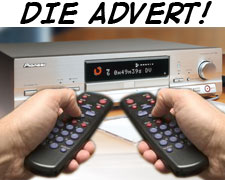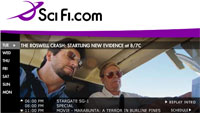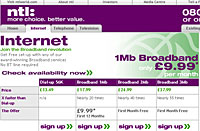 Back in the old days when Glastonbury was a field of medieval mud occupied by confused hippies and LSD travellers, the customary way to show your appreciation of the band was to flash the occasional peace sign or waft a spliff skywards.
Back in the old days when Glastonbury was a field of medieval mud occupied by confused hippies and LSD travellers, the customary way to show your appreciation of the band was to flash the occasional peace sign or waft a spliff skywards.
Come the punk revolution, and there was no better way to show your love for a band than by propelling copious amounts of phlegm in their direction.
By the 80s, over-excited fans felt the best way to express a heartfelt love for a band was to clamber onstage and then stage dive back into the audience, while the E’d up 90s rave generation couldn’t get it together to work out where the stage was so just swirled fluoro things around their person instead.
In America, it was a somewhat different story, with concert goers traditionally expressing a curious penchant for holding lighters aloft, a craze that never really caught on in Blighty because, frankly, it looks really daft.
 For today’s hi-tech toy generation, new ways of bigging up a band have developed.
For today’s hi-tech toy generation, new ways of bigging up a band have developed.
Mobile phones have ensured that lighters have been replaced by the blue glow of mobile phones, with forests of camera phones springing up and down at concerts like demented flamingos.
Not surprisingly, this swaying sea of interactive technology soon caught the attention of The Man, who quickly saw an opportunity to coin in it from the captive crowd.
Step forward Boomerang Mobile Media who, in partnership with Strategic Artists Management, have come up with the idea of allowing fans to send SMS messages to the band and then see their words appear on a big onstage screen. For a price, naturally.
Fans don’t even have to be at the gig, with sofa loafers stoned at home watching the gig on TV also able to ‘enjoy’ the thrill of seeing their texted mumblings appear onstage.
The concept’s already been tested out on a promotional tour for Anastacia in Europe, where around ten percent of the attendees were happy to hand over 1 euro each (~£0.68 ~US$1.26) for the privilege of blasting inane messages onstage for all to see.
 We’re not sure what the remaining 90% of the crowd thought of this pointless onscreen nonsense, but we’d be reaching for our phone zappers in double quick time.
We’re not sure what the remaining 90% of the crowd thought of this pointless onscreen nonsense, but we’d be reaching for our phone zappers in double quick time.
Call us old fashioned if you will, but when we go to gigs we want to see the band and not be distracted by an endless stream of “KT LUVS THE KLRZ 4EVER” and “WIL U MARRY ME THOM?” beaming in our faces.
Simon Renshaw, of Strategic Artists Management, soaked up every cash-till ringing minute of the show: “Fans loved the concept and were sending multiple text messages to our stage front screens in an effort to see their names, talk to their friends, tell Anastacia how much they love her and win prizes.”
“Fans were so excited about it that marriage proposals were proffered onscreen,” he gushed.
But the real profit may come from turning the band’s backdrop into a giant size virtual mall, with audiences able to call in and buy merchandise advertised throughout the gig.
Boomerang Mobile Media founder and CEO Glenn Field rubbed his hands and explained the scheme: “You see something you like, and we deliver it to your home.”
As Sid Vicious and the ghost of Rock’n’Roll reached maximum RPM in their graves, he continued, “These are exclusive items purchased through the security of your phone, and the day it should have arrived you’ll get a follow-up phone call to confirm you received it.”
Boomerang Mobile Media and Strategic Artists Management are already dreaming up additional e-commerce opportunities, including the ability to allow fans to send camera-phone pictures to the venue screens along with their text messages
No interactive stone is being left unturned in their attempts to fleece, sorry, offer maximum interactive retail opportunities, to the hapless punter.
The first time a consumer buys from Boomerang via a mobile, a live operator will jump into action and invite the user to register a personal PIN for future purchases and other products.
This can then be used to milk fans dry with subsequent mobile-only ‘exclusive’ offers, pre-orders and a myriad of other pocket-draining merchandising discounts.
Boomerang are applying the marketing experience they gained last year when working with Def Jam Recordings artist Ghostface on a festival bill.
“We allowed Ghostface to connect with fans who either were fans or who heard his music that day and became fans,” Field enthused.
“We projected a number inviting people to interact – to meet him, visit him on the tour bus, things like that – and when you called you heard a recorded message from Ghostface. People got to hear their favourite artist talk to them on their most personal device.”
Cash from chaos, anyone?
Boomerang Mobile Media
 Champagne corks were firing off at Google like a military salute as the Internet search engine kings revealed that their profits had jumped more than 300 per cent in the second quarter this year.
Champagne corks were firing off at Google like a military salute as the Internet search engine kings revealed that their profits had jumped more than 300 per cent in the second quarter this year.  The company’s fortunes are currently on a stratospheric trajectory, with April’s first-quarter profit almost six times higher than a year earlier.
The company’s fortunes are currently on a stratospheric trajectory, with April’s first-quarter profit almost six times higher than a year earlier.  TV advertisers and execs could be heard blubbing into their double tall skinny lattes all over Soho as a new survey revealed that around 90 percent of current users fast-forward through ads.
TV advertisers and execs could be heard blubbing into their double tall skinny lattes all over Soho as a new survey revealed that around 90 percent of current users fast-forward through ads.  With more and more consumers buying digital video recorders (DVRs), this could spell disaster for the advertising industry.
With more and more consumers buying digital video recorders (DVRs), this could spell disaster for the advertising industry.  Although the technology is still bubbling under the mainstream, BSkyB says about half of new subscribers opt for its Sky+ DVR, and with cable companies selling DVRs that are built into set-top boxes, advertisers are set for a bumpy ride ahead.
Although the technology is still bubbling under the mainstream, BSkyB says about half of new subscribers opt for its Sky+ DVR, and with cable companies selling DVRs that are built into set-top boxes, advertisers are set for a bumpy ride ahead.  Long shunned as hobby-obsessed lonely losers living in messy bedrooms with a dreadful taste in music, geeks, computer spods and sci-fi nuts have revealed themselves as a lucrative target for advertisers.
Long shunned as hobby-obsessed lonely losers living in messy bedrooms with a dreadful taste in music, geeks, computer spods and sci-fi nuts have revealed themselves as a lucrative target for advertisers.  The bigwigs of Sci-Fi conducted the research to try and work out the popularity of the multi-billion dollar genre when it was supposedly the province of “solitary, unpopular individuals with niche interests and questionable personal hygiene habits.”
The bigwigs of Sci-Fi conducted the research to try and work out the popularity of the multi-billion dollar genre when it was supposedly the province of “solitary, unpopular individuals with niche interests and questionable personal hygiene habits.”  The bit that will get the advertisers moist in their strap lines is the fact that geeks are 90% more likely to be the first among their chums to invest in new products.
The bit that will get the advertisers moist in their strap lines is the fact that geeks are 90% more likely to be the first among their chums to invest in new products.  NTL’s claim that 300K broadband offer was “more than 5 times faster than standard 56K dial-up internet” has been happy-slapped down by the Advertising Standards Authority (ASA), who condemned it as being in breach of TV Advertising Standards Code.
NTL’s claim that 300K broadband offer was “more than 5 times faster than standard 56K dial-up internet” has been happy-slapped down by the Advertising Standards Authority (ASA), who condemned it as being in breach of TV Advertising Standards Code.  The telecoms giant insisted that it was standard industry practice to refer to the speed of broadband only in terms of download speed and, to back up their case, readily snitched on a host of competitors making similar claims.
The telecoms giant insisted that it was standard industry practice to refer to the speed of broadband only in terms of download speed and, to back up their case, readily snitched on a host of competitors making similar claims.  The European Commission has announced plans to create a single set of European Union rules on broadcasting and the wireless spectrum.
The European Commission has announced plans to create a single set of European Union rules on broadcasting and the wireless spectrum.  Europe is also looking to free up the highly lucrative wireless spectrum – currently worth something like €9 billion (~US$11bn ~£6bn) a year – and hopes that digital frequencies used by services such as mobile phone operators, police radar and radio will be brought under centralised EU control by the end of 2005.
Europe is also looking to free up the highly lucrative wireless spectrum – currently worth something like €9 billion (~US$11bn ~£6bn) a year – and hopes that digital frequencies used by services such as mobile phone operators, police radar and radio will be brought under centralised EU control by the end of 2005.  Back in the old days when Glastonbury was a field of medieval mud occupied by confused hippies and LSD travellers, the customary way to show your appreciation of the band was to flash the occasional peace sign or waft a spliff skywards.
Back in the old days when Glastonbury was a field of medieval mud occupied by confused hippies and LSD travellers, the customary way to show your appreciation of the band was to flash the occasional peace sign or waft a spliff skywards.  For today’s hi-tech toy generation, new ways of bigging up a band have developed.
For today’s hi-tech toy generation, new ways of bigging up a band have developed.  We’re not sure what the remaining 90% of the crowd thought of this pointless onscreen nonsense, but we’d be reaching for our phone zappers in double quick time.
We’re not sure what the remaining 90% of the crowd thought of this pointless onscreen nonsense, but we’d be reaching for our phone zappers in double quick time.  UK’s first video mobile network, 3, has announced the first advert to be broadcast over a 3G service.
UK’s first video mobile network, 3, has announced the first advert to be broadcast over a 3G service.  The clip will be launched in mid-May and made available via ‘Today on 3’, with the first 100,000 customers able to download the clip for nowt.
The clip will be launched in mid-May and made available via ‘Today on 3’, with the first 100,000 customers able to download the clip for nowt.  Pamir Gelenbe, co-founder and Director of Corporate Development, Flytxt was equally chuffed: “We’re delighted to be working with 3, the UK’s leading 3G network on such an innovative approach to mobile marketing and advertising. The advantage for brand owners is that mobile marketing combines the wide reach of TV with the precision of DM and the tracking potential of the Internet. ”
Pamir Gelenbe, co-founder and Director of Corporate Development, Flytxt was equally chuffed: “We’re delighted to be working with 3, the UK’s leading 3G network on such an innovative approach to mobile marketing and advertising. The advantage for brand owners is that mobile marketing combines the wide reach of TV with the precision of DM and the tracking potential of the Internet. ”  In a quest to blast their already soaring profits further up into the stratosphere, Google will test a cost-per-impression bidding model for AdWords ads, letting advertisers specify groups of sites or specific sites in Google’s ad network.
In a quest to blast their already soaring profits further up into the stratosphere, Google will test a cost-per-impression bidding model for AdWords ads, letting advertisers specify groups of sites or specific sites in Google’s ad network.  Google has, however, promised limitations on the animated advertising fluff that can appear on their adverts, with blinking ads that continuously loop already declared verboten.
Google has, however, promised limitations on the animated advertising fluff that can appear on their adverts, with blinking ads that continuously loop already declared verboten.  The search engine heavyweights are hoping that the approach will appeal to advertisers who are fussy about where their brand appears or are aiming for a certain niche demographic.
The search engine heavyweights are hoping that the approach will appeal to advertisers who are fussy about where their brand appears or are aiming for a certain niche demographic.  Champagne corks were popping like manic machine gun fire at Google yesterday as the company reported a thumping fivefold increase in profits in the first quarter.
Champagne corks were popping like manic machine gun fire at Google yesterday as the company reported a thumping fivefold increase in profits in the first quarter.  Revenues generated from Google’s partner sites through its AdSense programs generated $584 million, or 47 percent of revenues, – a hefty 75 percent increase over partner-related revenues a year ago.
Revenues generated from Google’s partner sites through its AdSense programs generated $584 million, or 47 percent of revenues, – a hefty 75 percent increase over partner-related revenues a year ago.  Last week, 250 executives from advertising agencies, game developers and publishers swarmed into the first annual Advertising in Games Forum on 14 April 2005 in New York City.
Last week, 250 executives from advertising agencies, game developers and publishers swarmed into the first annual Advertising in Games Forum on 14 April 2005 in New York City.  For the benefit of buzzword-deficient execs, Yankee Group senior analyst Mike Goodman explained that this hideous word describes what you get when advertisers create a game around a product rather than place their brands within a well-known title.
For the benefit of buzzword-deficient execs, Yankee Group senior analyst Mike Goodman explained that this hideous word describes what you get when advertisers create a game around a product rather than place their brands within a well-known title.  Fact-bloated attendees also learned that the top selling 2004 game titles (according to the NPD Group) were:
Fact-bloated attendees also learned that the top selling 2004 game titles (according to the NPD Group) were: